|
|
|
Sort Order |
|
|
|
Items / Page
|
|
|
|
|
|
|
| Srl | Item |
| 1 |
ID:
151119
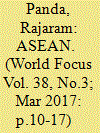

|
|
|
|
|
| Summary/Abstract |
The Association of Southeast Asian Nations (ASEAN), founded in 1967, has proved to be one of the most successful regional organisations, whose example as a model is often cited when similar ideas are floated elsewhere. Started initially with five core members, it subsequently expanded to the present ten countries as members of the organisation. The primary focus in the initial phase of its existence was on economic cooperation. In the subsequent years, it started embracing security/strategic issues and threats to non-traditional security keeping in tune with changing times. The latest in this journey is the founding of the ASEAN Economic Community, which was established in 2015. This essay examines its evolution, performance and some of the challenges confronting the organisation and what future holds for it.
|
|
|
|
|
|
|
|
|
|
|
|
|
|
|
|
| 2 |
ID:
140003
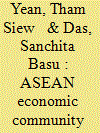

|
|
|
|
|
| Summary/Abstract |
The ten Southeast Asian economies will announce the formation of an ASEAN Economic Community (AEC) on 31 December 2015. The AEC aspires to deliver an integrated market and production base with the free movement of goods, services, capital and skilled labour. However, member economies are still a long way from achieving an integrated production space as they have not yet fulfilled all the stipulated targets set in the 2007 AEC Blueprint. A possible explanation for the current state of economic integration is the presence of conflicting domestic economic interests in member countries. This paper reviews the literature on this issue and synthesizes main observations from selected country studies examining the nature of these conflicting interests. It concludes by providing key policy recommendations for fostering domestic consensus in the respective countries studied in this special issue so that they may support the implementation of their respective commitments as well as deeper ASEAN economic integration beyond 2015.
|
|
|
|
|
|
|
|
|
|
|
|
|
|
|
|
| 3 |
ID:
121862
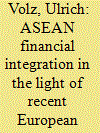

|
|
|
|
|
| Publication |
2013.
|
| Summary/Abstract |
This article reflects on the ambitions of the Association of Southeast Asian Nations (ASEAN) to foster regional economic and financial integration among its member countries against the backdrop of the European financial crisis. Based on a review of the European experiences with financial integration since the 1970s, this article critically examines the potential risks associated with the creation of a financially integrated ASEAN Economic Community and the implications for policy autonomy of ASEAN members. It outlines the regulatory and institutional requirements that need to be put in place in order to minimize financial stability risk if an integrated financial sector across ASEAN is aimed for.
|
|
|
|
|
|
|
|
|
|
|
|
|
|
|
|
| 4 |
ID:
154433


|
|
|
|
|
| Summary/Abstract |
The establishment of the ASEAN Economic Community (AEC) should transform this regional association of states into “single market and production base, a highly competitive economic region, a region of equitable economic development, and a region fully integrated into the global economy” (AEC Blueprint). The present study analyzes the current level of progress in introducing a regional competition law and policy that would create a level playing field for the businesses within the AEC. The paper also addresses the functionality of current “ASEAN way” of coordinating the enforcement of the national competition laws across the ASEAN jurisdictions. The second part of the study outlines the experiences of the decade of decentralized enforcement of competition rules within the Internal Market of the European Union (EU) through cooperation and coordination between the EU Commission and national competition authorities (NCAs) of the EU Member States within the European Competition Network (ECN). Special focus of the research is on the “effect on trade”, which is used as a jurisdictional criterion that determines application of the EU competition rules and national competition rules. The lessons from the functioning of the ECN can be instructive for the development of the regional framework for competition law and policy in the AEC and wider Asia-Pacific region, where the growing number of the national competition law regimes require cooperation and coordination among the NCAs and more generally between the states under the multitude of regional free trade agreements and bilateral investment treaties, which often contain competition enforcement obligations.
|
|
|
|
|
|
|
|
|
|
|
|
|
|
|
|
| 5 |
ID:
150814


|
|
|
|
|
| Summary/Abstract |
We investigate energy security of the Association of Southeast Asian Nations (ASEAN) under the 4-A’s framework. The ASEAN Economic Community (AEC) agreement launched in 2015 renewed a regional focus on energy security and sustainability. We employ an analytic framework to quantitatively assess progress in different categories including availability, acceptability, affordability, and applicability. Key metrics include the documentation of CO2 emissions, energy access measures, and energy supply reserves from 2005–2010. We identify relevant energy indicators using high quality historical data from the IEA and World Bank. We find that ASEAN made little progress toward establishing energy security in the previous five-year planning period (2005–2010) as it regressed in most categories except applicability. Therefore, we suggest that increased development of renewable energy and energy efficiency technologies would move ASEAN in a positive direction toward achieving energy security and sustainable energy policy goals.
|
|
|
|
|
|
|
|
|
|
|
|
|
|
|
|
| 6 |
ID:
148306
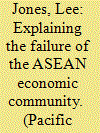

|
|
|
|
|
| Summary/Abstract |
All reliable indicators suggest that ASEAN's (Association of Southeast Asian Nations) Economic Community (AEC) will not be successfully established by its 2015 deadline. Why? Against technocratic, realist and constructivist accounts, this article offers an explanation rooted in the political economy of ASEAN's member-states. Economic liberalisation agreements promote the rescaling of economic governance, involving regulatory changes that may radically redistribute power and resources. Consequently, they are heavily contested between coalitions of social and political forces, without outcomes reflecting the outcome of these struggles. The argument is demonstrated by exploring the uneven sectoral liberalisation achieved under the AEC, the constrained integration of ASEAN's energy markets, and the limited deregulation of skilled labour migration.
|
|
|
|
|
|
|
|
|
|
|
|
|
|
|
|
| 7 |
ID:
101936
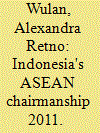

|
|
|
| 8 |
ID:
113840
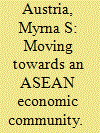

|
|
|
|
|
| Publication |
2012.
|
| Summary/Abstract |
Why are the ASEAN economies increasingly becoming anxious about regional integration? To stay competitive is an obvious answer. Greater cohesion is also imperative for ASEAN to sustain its credibility of being able to provide the platform for interactions in East Asia and the rest of the world. Yet what is offered by the ASEAN Free Trade Area, the ASEAN Framework Agreement on Services, and the ASEAN Investment Area may not be adequate or comprehensive enough for the Association to amass the economic clout commensurate with its position as a pivotal player in East Asia. The ASEAN Economic Community is thus the logical, but not automatic, extension of these regional efforts. Can it come to fruition? This paper discusses how the ASEAN economies may address key issues that have hampered deeper economic integration in the region.
|
|
|
|
|
|
|
|
|
|
|
|
|
|
|
|
| 9 |
ID:
152286


|
|
|
|
|
| Summary/Abstract |
For decades, Myanmar’s economic system has been characterized by central planning and international isolation. Today, as the country undergoes a far-reaching political and economic transition, it is leaving this past behind. For Myanmar’s enterprises, and SMEs in particular, the opening of the country’s economy and the intensification of regional economic integration through the ASEAN Economic Community brings both opportunities and challenges. It is in this context that the present study investigates the extent of Myanmar SME participation in ASEAN and East Asian regional economic relations as well as the challenges they face and the policy support they need for deeper integration. More specifically, this paper addresses the following four questions: What is the state of Myanmar SMEs’ participation in regional trade, production networks, and investment activities? What are the enabling factors and obstacles to SME participation in regional economic activities? How are regional and preferential trade agreements affecting SMEs’ activities and performance? And what are the policy imperatives to promote active participation of Myanmar SMEs in regional economic integration? To find answers to these questions, this study not only analyses existing secondary data but also draws on a new dataset collected by the Centre for Economic and Social Development (CESD) through a survey among Myanmar enterprises which focuses on the food-processing and garment sectors. It is found that, at present, Myanmar SMEs hardly participate in regional economic activities. They face numerous challenges such as: constrained access to capital and skills; limited investment in technology, innovation and human capital; minimal usage of ICT; and low awareness of regional integration dynamics. To overcome these challenges and reap the benefits of regional economic integration, enhanced firm-level efforts are needed while the government can provide support on various fronts.
|
|
|
|
|
|
|
|
|
|
|
|
|
|
|
|
| 10 |
ID:
152289
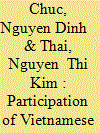

|
|
|
|
|
| Summary/Abstract |
Small and medium enterprises are prevalent in Vietnam. They are also the predominant type of enterprise in the three manufacturing industries surveyed: food; apparel; and wood products. These have been the emerging export sectors in the last decade. The survey shows that SMEs in these sectors are highly aware of ASEAN’s plan for SME development and perceive that the ASEAN Economic Community is beneficial to business. However, the share of SMEs that have business relations with firms in other ASEAN economies is small. There is also limited awareness of Vietnam’s Free Trade Agreements. The regression analysis reveals that foreign ownership and productivity are the two most important determinants of Vietnam SMEs’ participation in production networks. Product innovation, process innovation and membership in business associations also significantly increase the probability that SMEs participate in production networks. The analysis suggests that policies to develop SMEs, increase labour productivity, and intensify international integration will facilitate SMEs’ participation in regional production networks. Government can also craft policies to promote innovation, encourage membership in industry and business associations, and raise awareness of ASEAN’s SME development plans, the AEC and other business related issues.
|
|
|
|
|
|
|
|
|
|
|
|
|
|
|
|
| 11 |
ID:
144822


|
|
|
|
|
| Summary/Abstract |
Increasing regional economic integration amongst ASEAN member countries, and the creation of the ASEAN Economic Community (AEC) will bring both opportunities and challenges for local firms. This research investigates the perception and understanding of five Vietnamese food processing companies towards the AEC as well as their planned responses towards deeper integration. Case study interviews revealed that respondents had a limited understanding of the AEC, which moderated their strategic responses. Opportunities identified include access to new markets, the possibility of exploiting regionwide resources, and access to regional value chains. Increased competitive pressure, particularly from foreign investors, was the key anticipated challenge. Business responses focused on increasing intra-regional exports, cooperating with potential partner organizations, improving products and processes, and revising marketing strategies. Respondents also believed that the Vietnamese government could do more to support their businesses in the face of deepening economic integration.
|
|
|
|
|
|
|
|
|
|
|
|
|
|
|
|
| 12 |
ID:
152287
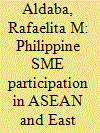

|
|
|
|
|
| Summary/Abstract |
This study aims to examine the extent and nature of Philippine SME participation in ASEAN economic integration. Based on a survey of 205 establishments, the results indicate that out of 205 firms, 41 per cent are FTA users, of which 48 (or 40 per cent) are SMEs while 33 (44 per cent) are large enterprises. The survey shows that although most firms are aware of the AEC (ASEAN Economic Community), they still have limited knowledge about the more specific impact of AEC on their business operations. About 62 per cent of SMEs are unaware of how the AEC would affect their business operations. Regarding the perceived effects of FTAs on SMEs, 53 per cent of the respondents indicated that they do not know, have no opinion or have no response. The major reason cited by firms for not using FTAs is they do not know how to use them. The regression analysis on the determinants of FTA use shows that the coefficients on firm size, age, exporting, foreign ownership, engaging in innovation, membership in industry association, and awareness of the AEC are all positive and significant. In terms of government support and assistance, the survey results indicate that only a small proportion of the respondent firms are being reached by existing government programmes. The results reaffirm the need for more substantial awareness programmes especially on how to use FTAs and how firms can take advantage of the opportunities arising from AEC integration and other FTAs.
|
|
|
|
|
|
|
|
|
|
|
|
|
|
|
|
| 13 |
ID:
152291
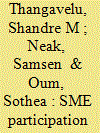

|
|
|
|
|
| Summary/Abstract |
This study employs survey data of 201 firms to explore the impact of trade policy on small and medium size enterprises (SMEs) in Cambodia. The results show that more than half of the surveyed firms were aware of the ASEAN Economic Community (AEC) and larger firms tend to use FTAs more frequently than SMEs. The key reasons identified in the study for not using the FTAs were mainly due to a lack of knowledge and also due to the complexity on the submissions of the required FTA forms. The strong import linkages with ASEAN and East Asia (as compared to export linkages) suggest that Cambodian firms take advantage of sourcing for cheaper intermediate inputs from ASEAN and East Asian economies and then export the final products to the U.S. and EU markets through generalized system of preferences (GSP) and Everything But Arms (EBA) arrangements. The results of the survey indicate that the perception that the AEC has or would decrease their domestic and export sales as well as their profitability, and face more competition in local and foreign markets. On the other hand, they think the AEC has or would decrease import costs and enhance accessibility to intermediate inputs. The impacts are believed to occur through the reduction of import and export tariffs/duties, increase in custom procedures, standards and regulations, recognition of professional qualifications, improved investment processes, and better connectivity. The empirical results indicate that compared to non-users, the active FTA users appear to be larger firms, have higher labour productivity, and have experience with multiple export markets. They are also members of business associations and have higher skill intensity and technological capability. Firm size, higher labour productivity, access to business networks, active use of information and communications technology (ICT), having more experiences with multiple export markets, skilled human capital and technological capability are important factors for firms to use multiple FTAs and participate in regional integration.
|
|
|
|
|
|
|
|
|
|
|
|
|
|
|
|
| 14 |
ID:
111024
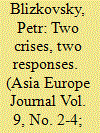

|
|
|
|
|
| Publication |
2012.
|
| Summary/Abstract |
The financial crisis of 1997/1998 in Southeast Asia triggered institutional developments inside the Association of Southeast Asian Nations (ASEAN) and beyond. They deepened intra-regional cooperation in the economic area and laid down the foundations for the ambition of creating an ASEAN Economic Community that would allow easier exchanges of productive factors. Concurrently, ASEAN also widened its response in the financial domain by initiating various "ASEAN plus" arrangements to pool risks and address volatility in financial markets. The European Union (EU) was hit by the global financial crisis in 2008 and subsequently by the sovereign debt crisis. The EU response to this has been a deepening of legally binding macroeconomic cooperation and the strengthening of the regulatory framework. On top of this, and contrary to the ASEAN case, the EU 27-Minus initiatives go further towards closer political coordination. In parallel, the legally binding scheme has been adopted to strengthen the stability of the Euro Area. This paper analyses the policy responses in both regions to their respective crises. It aims at understanding the driving forces behind the different policy responses, looking at both the region-specific and the more generic institutional and regulatory responses to the crises.
|
|
|
|
|
|
|
|
|
|
|
|
|
|
|
|
| 15 |
ID:
138139
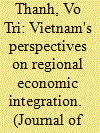

|
|
|
|
|
| Summary/Abstract |
This paper revisits Vietnamese perspectives on regional economic integration. Proactive economic integration has been an important pillar of Vietnam’s economic reforms. The country’s current economic integration process involves preparation for the ASEAN Economic Community (AEC) and the negotiation of ambitious free trade agreements such as the Trans-Pacific Partnership (TPP) and Regional Comprehensive Economic Partnership (RCEP) agreements. As the umbrella organization for Vietnam’s economic integration, ASEAN continues to forge the country’s trade and investment linkages with the region. The AEC is making progress, but certain challenges remain with the overall management of regional cooperation, improvements to ASEAN centrality and connectivity, and issues related to contemporary regional and non-traditional security. RCEP and TPP represent recent ambitious efforts to promote economic integration. Notwithstanding their potential benefits, RCEP and TPP may produce different outcomes, including trade diversion, for major economies. These two trade agreements have various similarities and differences, but they exhibit potential consistency with the concept of a Free Trade Area of the Asia Pacific. Vietnam’s economy may benefit immensely from ongoing integration efforts. Still, such benefits are conditional on relevant and timely domestic reforms, particularly of economic institutions, state-owned enterprises and public investment. The harmonization of commitments under various economic integration tracks and improvements to market confidence is also critical.
|
|
|
|
|
|
|
|
|
|
|
|
|
|
|
|
|
|
|
|
|